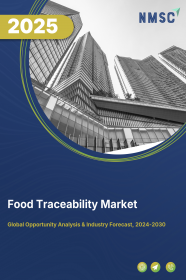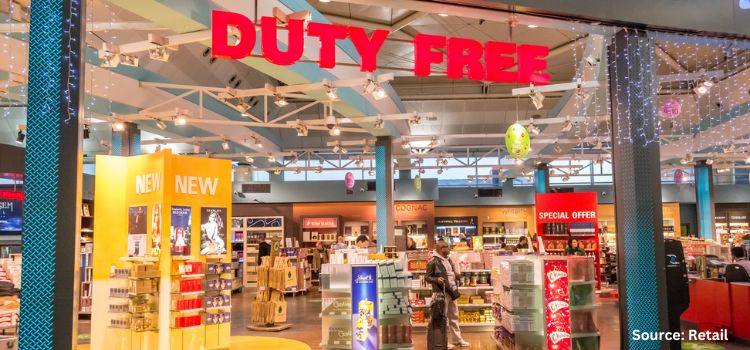
Food Traceability Market by Type (Internal Traceability, External Traceability, Backward Traceability, and Forward Traceability), by Technology (Barcode, Radio Frequency Identification (RFID), Blockchain technology, DNA-based traceability, Mobile traceability, IoT (Internet of Things), GPS (Global Positioning System)), and Others - Global Opportunity Analysis and Industry Forecast, 2020 – 2030
US Tariff Impact on Food Traceability Market
Trump Tariffs Are Reshaping Global Business
Market Definition:
The Global Food Traceability (Tracking Technology) Market size was valued at USD 12.86 billion in 2019 and is predicted to reach USD 29.43 billion by 2030, with a CAGR of 7.8% from 2020-2030.
Food traceability is a tracking technology that traces and validates the product quality at each point in the food supply chain, starting from production, processing, packaging, to distribution. It plays a vital role in the global trade, where food products from different origins are traded internationally, and food-investigation becomes mandatory in quality-checking the freshness-quotient of food products.
Food traceability holds wide application in tracing meat & livestock, fisheries, dairy products, fresh produce, and other perishables. The technologies used for food traceability are majorly thermal Printer, 2D & 1D barcode scanners, tags & labels, PDA with GPS, sensors, and others.
Market Dynamics and Trends
According to the ‘Food Safety’ report provided by World Health Organization in April 2020, about 1 in 10 million people, i.e. an approximated 600 million people world-wide fall ill after eating contaminated food, with an estimated 420,000 people dying every year from food borne diseases. The increasing prevalence of contaminated food causing food borne diseases, rises the demand for efficient food traceability technologies, thereby augmenting the growth of global food traceability market over the forecast period.
Major factors driving the growth of global food traceability market are stringent regulatory standards regarding food safety, mandatory standardization procedures to be followed by manufacturers coupled with food certifications mandated by government authorities.
However, investments in food traceability technologies resulting to higher cost to the company, intruding privacy, and security concerns, are the limiting factors hampering the growth of global food traceability market. Moreover, highly competitive global food traceability market, ease of tracking with product recalls, information flow in both upstream & downstream food supply chain, as well as increasing penetration of company brandings and loyalty chains, are the factors anticipated to create lucrative segments for the growth of global food traceability market in coming future.
Market Segmentations and Scope of the Study:
The global food traceability market share has been analyzed based on equipment, technology, application, end user, and geography.
Based on equipment, the food traceability market is segmented into PDA with GPS, thermal Printers, 2D & 1D scanners, tags & labels, sensors, and others. Based on technology, the food traceability market is fragmented into RFID/RTLS, GPS, barcode, infrared, and biometrics. Based on application, the food traceability market is categorized into meat & livestock, fresh produce & seeds, dairy, beverages, fisheries, and others. Based on end user, the food traceability market is divided into food manufacturers, warehouse/pack farms, food retailers, defense & security departments, government departments, and others. Geographic breakdown and analysis of each of the previously mentioned segments include regions comprising North America, Europe, Asia-Pacific, and RoW.
Geographical Analysis
North America is expected to account for the major market share in the global food traceability market, throughout the forecast period, owing to the increased adoption of food tracking technologies, stringent regulations, and mandate certificates to be obtained by manufactures regarding food safety in the food traceability market.
Asia Pacific is expected to illustrate a rapid growth in the global food traceability market, with developing market share, growing with the highest CAGR values throughout the forecast period. This is attributed to proliferating food traceability market specifically in emerging economies, as well as improvement in warehouse Logistics.
Competitive Landscape
The food traceability market, which is highly competitive, consists of various market players. Some of the major market players include AGRIVI, Honeywell International Inc., Trustwell, Zebra Technologies Corp., Aptean, TraceX Technologies Private Limited, Optel Group, Dock Labs AG, Stevens Traceability Systems Ltd, Trace Food, iFooDS, SAP, Bumble Bee Foods LL.C., Cognex Corporation, C.H. Robinson Worldwide, Inc., among others. The key players are employing strategies such as product launches, joint ventures, and technical collaboration, in-order to gain stronger position in the food traceability market.
For instance, in April 2020, Cognex Corporation, one of the leading companies in food traceability market, launched its ‘DataMan 475,’ the inline barcode verifier that provides contract-compliant assurance abiding to ISO standards. Its high-resolution camera, precision optics, and powerful lighting delivers the most quality reporting and reliable code verification for 1D, 2D, and DPM codes.
In May 2020, the ‘Umbria Food Cluster Project,’ by International Business Machines Corporation, gained momentum when the four major giants of food traceability market based in Italy viz, Gruppo Grigi, I Potti de Fratini, Molitoria Umbra, and Agribosco joined the network to promote authenticity and quality of products, using the IBM blockchain technology, locally as well as globally. This technology allows to track every internally-managed steps from farm-harvesting, processing, packaging, to final distribution, henceforth ensuring complete traceability and transparency. The food-unit includes pasta aliveris, eggs and egg products, chicken, honey, flour, sausages, dairy products, and other perishables. 2020 is the year where the whole world has united to fight the COVID-19 pandemic. The market players are contributing their part by developing and deploying new technologies that assists in fighting novel corona virus.
In May 2020, SGS SA., one of the major players in the food traceability market, announced that it has developed a range of new SARS-CoV-2 testing solutions that shall support the whole food-supply chain, from manufacturing to commercialization, to distribution in public facilities. The testing kits assures to detect the presence of novel corona virus in the consumables, at any point of the supply chain. SGS’s Hygiene Monitored (HM) Program, is compliant with World Health Organization guidelines, and covers swabbing, transporting, and testing of samples. For sample testing, the Reverse Transcription Real-Time PCR test is used to extract and detect the viral RNA, with high sensitivity.
Key Benefits
-
The food traceability market report provides the quantitative analysis of the current market and estimations through 2020-2030 that assists in identifying the prevailing market opportunities to capitalize on.
-
The study comprises a deep dive analysis of the food traceability market trend including the current and future trends for depicting the prevalent investment pockets in the market.
-
The report provides detailed information related to key drivers, restraints, opportunities, and their impact on the food traceability market.
-
The report incorporates competitive analysis of the market players along with their market share in the global food traceability market.
-
The SWOT analysis and Porters Five Forces model is elaborated in the study of the food traceability market.
-
Value chain analysis in the food traceability market study provides a clear picture of the stakeholders’ roles.
Key Market Segments:
By Type
-
Internal Traceability
-
External TraceabilIy
-
Backward Traceability
-
Forward Traceability
By Technology
-
Barcode
-
Radio Frequency Identification (RFID)
-
Blockchain technology
-
DNA-based traceability
-
Mobile traceability
-
IoT (Internet of Things)
-
GPS (Global Positioning System)
By Software
-
Warehouse Management
-
Laboratory Information Management System (LIMS)
-
Enterprise Resource Planning (ERP)
-
Statistical Process Control
-
Others
By Application
-
Meat And Livestock
-
Fresh Produce And Seeds
-
Dairy
-
Beverages
-
Fisheries
-
Other Application
By Region
-
North America
-
The U.S.
-
Canada
-
Mexico
-
-
Europe
-
The UK
-
Germany
-
France
-
Italy
-
Spain
-
Denmark
-
Netherlands
-
Finland
-
Sweden
-
Norway
-
Russia
-
Rest of Europe
-
-
Asia-Pacific
-
China
-
Japan
-
India
-
South Korea
-
Australia
-
Indonesia
-
Singapore
-
Taiwan
-
Thailand
-
Rest of Asia Pacific
-
-
Rest of the World
-
Latin America
-
Middle East
-
Africa
-
Key Players
-
AGRIVI
-
Honeywell International Inc.
-
Trustwell
-
Zebra Technologies Corp.
-
Aptean
-
TraceX Technologies Private Limited
-
Optel Group
-
Dock Labs AG
-
Stevens Traceability Systems Ltd
-
Trace Food
-
iFooDS
-
SAP
-
Bumble Bee Foods LL.C.
-
Cognex Corporation
-
C.H. Robinson Worldwide, Inc.
REPORT SCOPE AND SEGMENTATION:
|
Parameters |
Details |
|
Analysis Period |
2019–2030 |
|
Base Year Considered |
2020 |
|
Forecast Period |
2020–2030 |
|
Market Size Estimation |
Billion (USD) |
|
Market Segmentation |
By Equipment (PDA with GPS, Thermal Printers, 2D & 1D Scanners, Tags & Labels, Sensors, and Others), by Technology (RFID/RTLS, GPS, Barcode, Infrared, and Biometrics), by Application (Meat & Livestock, Fresh Produce & Seeds, Dairy, Beverages, Fisheries, and Others), by End User (Food Manufacturers, Warehouse/Pack Farms, Food Retailers, Defense & Security Departments, Other Government Departments, and Others) |
|
Geographical Segmentation |
North America (U.S., Canada, Mexico) Europe (UK, Germany, Italy, France, Rest of Europe), Asia-Pacific (China, Japan, India, Australia, Rest of APAC), Rest of the World (UAE, Saudi Arabia, South Africa, Brazil, Remaining Countries) |
|
Companies Profiled |
CH Robinson Worldwide Inc., Bio-Rad Laboratories, Inc., E. I. Du Pont de Nemours and Company (DuPont), Cognex Corporation, International Business Machines Corporation, Honeywell International Inc., SGS SA, Motorola Solutions, Inc., MASS Group Inc, and Zebra Technologies Corporation |

















 Speak to Our Analyst
Speak to Our Analyst





















